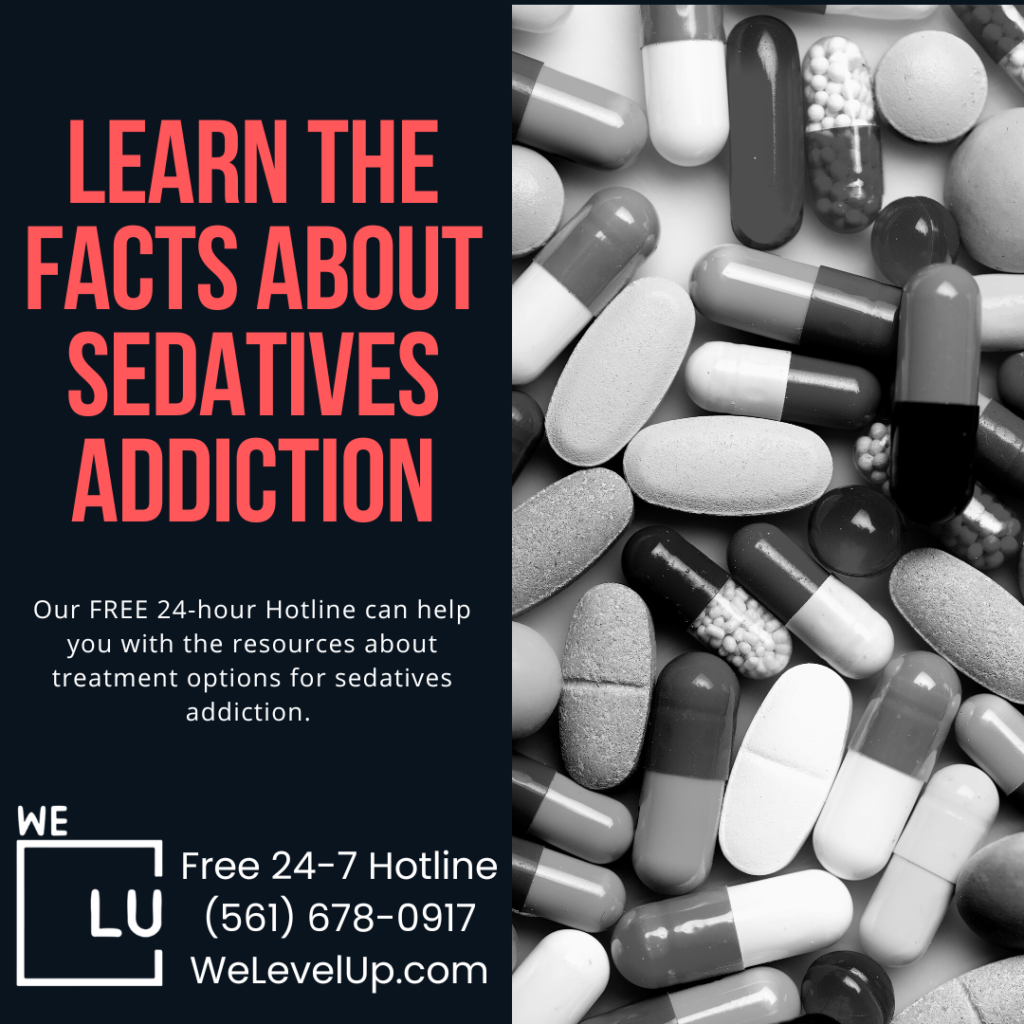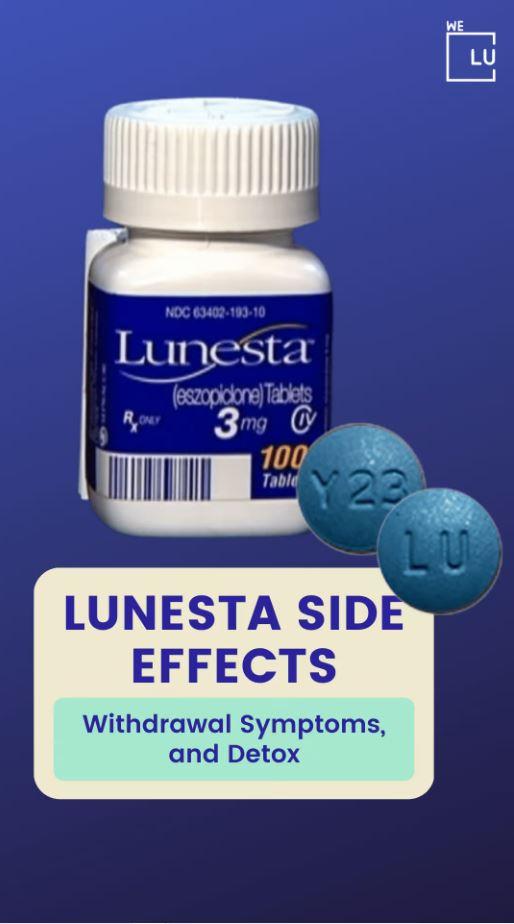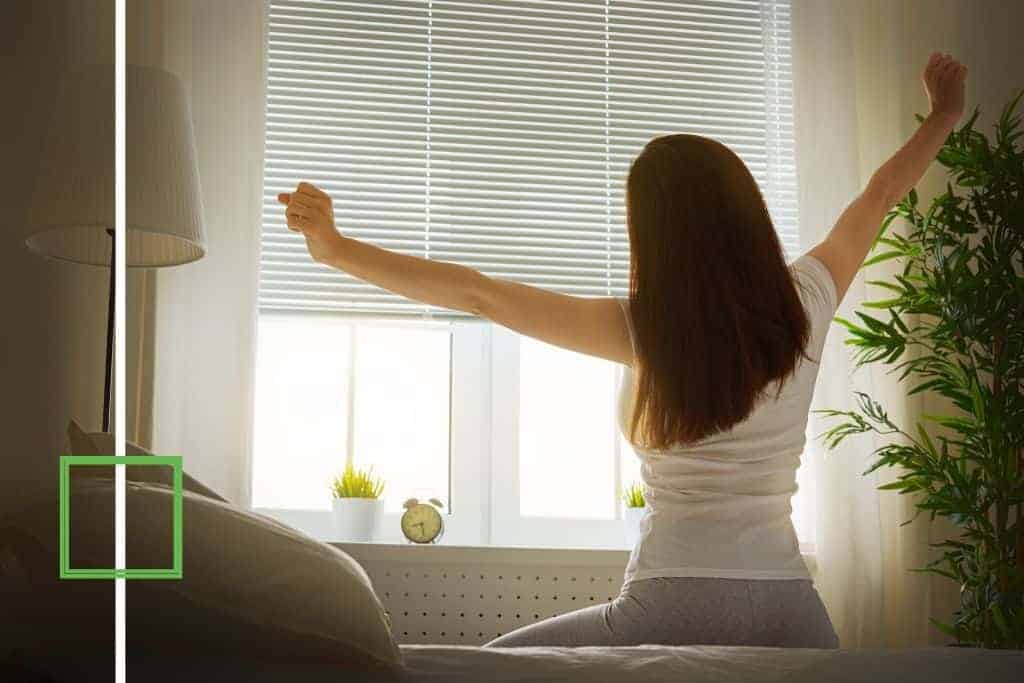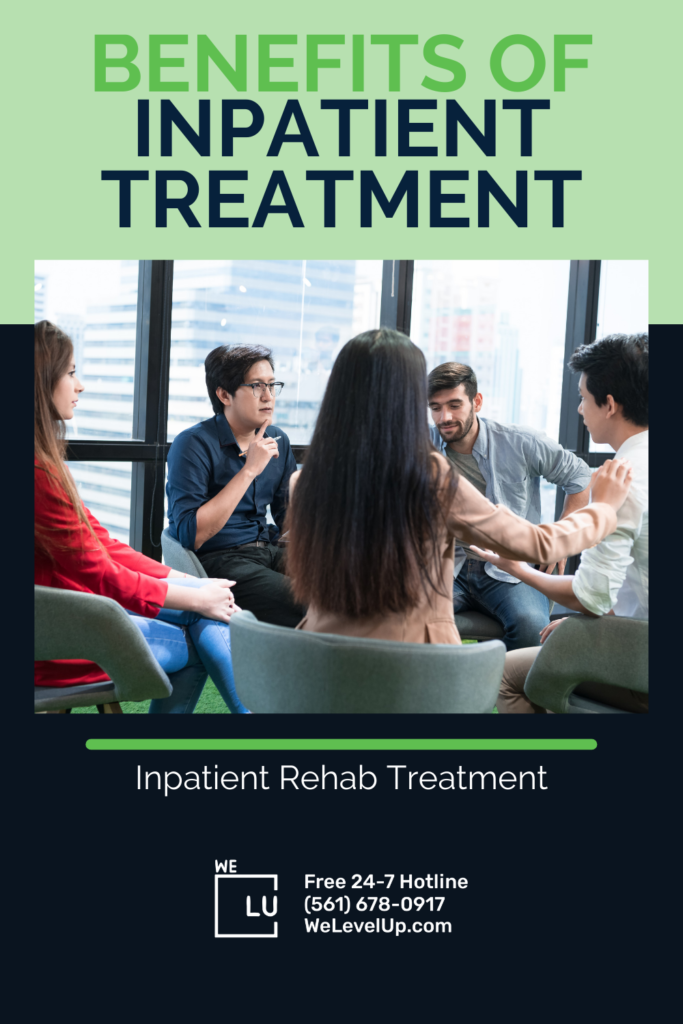Lunesta Detox Timeline, Withdrawal Symptoms, & Treatment
The duration of Lunesta detox and rehabilitation programs are determined by the individual circumstances and the severity of the addiction. It's crucial to work with a healthcare professional to get the most appropriate course of treatment and to ensure that you have the support and resources you need to successfully overcome your dependency to Lunesta. Read more about Lunesta detox symptoms, timeline, and the best treatment options.
By We Level Up | Editor Yamilla Francese | Clinically Reviewed By Lauren Barry, LMFT, MCAP, QS, Director of Quality Assurance | Editorial Policy | Research Policy | Last Updated: May 12, 2023
Lunesta Detox Overview
Many people worldwide use Lunesta to help with insomnia and other sleep-related issues. However, it is possible to become addicted to this medication accidentally. People frequently misuse and abuse Lunesta with alcohol and opioid drugs, increasing the risk of dependence and overdose. Someone suffering from addiction likely understands that continued drug use has numerous consequences; however, the person continues to use it anyway. After becoming addicted, users may experience severe lunesta withdrawal symptoms. And the only natural way to treat this issue is through a Lunesta detox.
Lunesta, brand name for eszopiclone, is a prescription sedative and non-benzodiazepine hypnotic. It is prescribed to treat insomnia. Lunesta drug is one of the most popular prescription medications for sleeping problems in the US. Although researchers are not exactly sure how it affects and changes the brain’s function, it is believed that Lunesta interacts with GABA receptors to help promote restful and more regulated sleep.
Lunesta Withdrawal Timeline
The Lunesta withdrawal timeline can vary from person to person, and some people may experience more severe symptoms for longer. Suppose you are planning to withdraw from Lunesta. In that case, it’s critical to work closely with your healthcare provider to develop a tapering plan that will help you minimize your symptoms and avoid any potential complications.
| Day 1-3 | Within a few days of stopping Lunesta, you may experience rebound insomnia, which is the recurrence of the sleep issues that led you to take the medication in the first place. You may also experience anxiety, irritability, and agitation. |
| Day 4-7 | As you withdraw from Lunesta, you may experience more severe symptoms, including tremors, sweating, and headaches. You may also experience gastrointestinal distress, including nausea, vomiting, and diarrhea. |
| Days 8-14 | By the second week of withdrawal, your symptoms may improve, although you may still experience some residual symptoms. You may still have trouble sleeping and feel fatigued during the day. You may also continue to experience mood swings, including anxiety and depression. |
| Days 15-30 | Most of your symptoms should have subsided by the end of the first month of withdrawal. You may still experience lingering effects, including mild insomnia and mood swings. |
Lunesta Withdrawal Symptoms
If you use Lunesta for an extended period and suddenly stop, you will likely experience uncomfortable withdrawal symptoms. Lunesta withdrawal may manifest through the following:
- In more extreme cases, those who quit Lunesta may experience anxiety attacks and seizures.
- One of the Lunesta withdrawal symptoms is fatigue which may be due to increased anxiety affecting your ability to sleep and making you tired throughout the day. Focus on fatigue because it can significantly impact your career and quality of life, making it worth addressing immediately.
- Some users report constant low-level anxiety throughout the day that may continue into the night and affect their ability to sleep.
- Nausea is one of the most annoying symptoms of withdrawal from Lunesta. This is not a mild sickness caused by simple things like seasonal allergies. Instead, withdrawal can lead to effects such as frequent vomiting.
- You may experience memory issues from Lunesta withdrawal, making you seem absent-minded and forgetful. Others have reported undergoing long periods of activity and having no memory of the events, ranging from eating a meal to even having sex!
- One of the more shocking Lunesta withdrawal side effects is mood swings which may be both violent and sudden. Both the use of and withdrawal from Lunesta affects GABA receptors in your brain, which causes mood swings and other mental issues.


Skip To:
Learn More:
- Can You Overdose on Sleeping Pills? Sleeping Pills Overdose Causes, Dangers & Emergency Treatment.
- Sedatives Addiction: Symptoms, Dependence, Treatment
- Addiction Treatment Center and Dual Diagnosis
- Depressant Drugs Health Risks & Treatment
- Medical Detox Treatment
- Substance Abuse Detox Centers
- Withdrawal Symptoms of Prescription Drugs
- Prescription Pill Detox Program
- Risks of Mixing Prescription Drugs With Alcohol
- 10 Most Abused Prescription Drugs In The US
Lunesta Drug Facts
Generic Name: Eszopiclone ( e-ZOP-i-klone )
Drug Class: Sedatives, miscellaneous anxiolytics, and hypnotics
Understanding Lunesta Addiction
Unlike other sleep-aid medications, such as benzodiazepines, Lunesta contains zopiclone, a hypnotic agent. The DEA (Drug Enforcement Administration) classifies Lunesta as a Schedule IV controlled substance because it has the potential for abuse and addiction.
The following terms are street names or slang for Lunesta:
- R2.
- Roche.
- Forget-Me Pill.
- Mexican Valium.
Once you use Lunesta, there is an impact on your health. Severe physical and psychological side effects can occur because of Lunesta abuse.
Short-term side effects of Lunesta abuse may include:
- Coordination impairment.
- Depression.
- Memory loss.
Lunesta Detox Timeline
The withdrawal timeframe for Lunesta might vary considerably. To begin with, persons who used Lunesta briefly and in tiny dosages may not experience withdrawal symptoms. On the other hand, individuals who have used the medication excessively and continuously may endure withdrawal symptoms that stay for weeks or even months.
Most patients experience withdrawal symptoms one to two days after their final Lunesta dosage. Anxiety and sleeplessness are common first symptoms. Lunesta withdrawal symptoms often peak between three and seven days. Most people’s symptoms improve within three weeks and finally vanish. However, if you strongly depend on Lunesta, you may have withdrawal symptoms for up to eight weeks following your last medicine dosage.
A planned detox is the best way to deal with your withdrawal symptoms. Many people try to detox on their own in their own homes. Unfortunately, they may end up experiencing even worse side effects that last over a more extended period without medical assistance—most of the severe withdrawal symptoms we have listed come from individuals who tried detoxing alone. Instead of making things better, it progressively made things worse. Therefore, medical detox is beneficial.
If you’re struggling with addiction to Lunesta, our qualified Lunesta detox treatment center can help. Turn to We Level Up for compassionate recovery services.

Get Your Life Back
Find Hope & Recovery. Get Safe Comfortable Detox, Addiction Rehab & Dual Diagnosis High-Quality Care.
Hotline(844) 597-1011Lunesta Usage Statistics
Lunesta (eszopiclone) is a prescription medication used to treat insomnia, but it can be habit-forming if taken for a long time or in higher doses than prescribed. Addiction to Lunesta is characterized by a compulsive drug-seeking behavior, despite negative consequences and withdrawal symptoms when stopping the medication. It’s not an illicit drug, but you will see through the statistics below how sedatives, such as Lunesta, can cause significant problems like drug dependency.
10 Million
The CDC (Centers for Disease Control and Prevention) estimates that 10 million US citizens use prescription sleep medications like Lunesta.
Source: CDC
21 Million
According to the FDA (Food & Drug Administration) study, about 21 million US citizens were admitted to abusing prescription sleeping pills like Lunesta at least once.
Source: FDA
1.9 Million
In 2018, roughly 1.9 million individuals aged 12 or older reported misusing sedatives, including Lunesta. Misusing sedatives can lead to substance use disorder, dependence, and other health problems.
Source: NSDUH
Importance Of A Lunesta Detox Program
Lunesta detox is removing toxins from the body, such as abused drugs. Detoxification can be done on a residential or inpatient basis, depending on the severity of the Lunesta withdrawal effects and the level of support needed. Generally, Lunesta detoxification involves the following steps:
- Assessment: A healthcare professional will assess your physical and mental health and the extent of your substance use. They will also evaluate any underlying medical or mental health conditions impacting your detoxification process.
- Medication: Depending on your symptoms, your healthcare provider may prescribe medication to manage your withdrawal symptoms. In the case of Lunesta detox, this may include tapering off the medication gradually over a period of weeks.
- Support: Lunesta detox can be challenging, and having a support system can be helpful. This may include individual or group therapy, family counseling, and peer support groups.
- Monitoring: During the Lunesta detox, your healthcare provider will monitor your vital signs and mental health to ensure safety and comfort.
Medical Lunesta Detox
Lunesta detox can be very uncomfortable and causes many people to relapse to relieve unpleasant withdrawal symptoms. Medical detox programs reduce the likelihood of relapse because clients are housed in a supportive and sober environment. If you are worried about suffering from the side effects of Lunesta withdrawal, there is an easy solution. Instead of facing the issue alone, you can work with a local detox center.
The safest way to manage withdrawal symptoms is to taper down the dosage gradually. It is best to taper down Lunesta under the supervision of a physician. Slowly tapering off Lunesta can help avoid the most severe withdrawal symptoms and medical consequences.

Get Help. Get Better. Get Your Life Back.
Searching for Accredited Drug and Alcohol Rehab Centers Near You?
Even if you have failed previously and relapsed, or are in the middle of a difficult crisis, we stand ready to support you. Our trusted behavioral health specialists will not give up on you. When you feel ready or just want someone to speak to about therapy alternatives to change your life call us. Even if we cannot assist you, we will lead you to wherever you can get support. There is no obligation. Call our hotline today.
(844) 597-1011Lunesta Detox Treatment
The We Level Up research has allowed us to develop a simple withdrawal timeline that may help you as you battle these Lunesta withdrawal symptoms. A significant warning sign is withdrawal symptoms lasting over a month and a half. This is usually a sign that you need help with the Lunesta detox. Once again, this comes down to the simple fact that everyone’s bodies are different. And that other people can react to the drug and withdrawal in many ways. Keep in mind that professional detoxing can also be a preventative measure. Do not wait until you are in excruciating pain to seek expert assistance.
Stages of Lunesta Detox
We Level Up’s medically supervised Lunesta detox occurs across three distinct stages. Each stage targets different elements of the Lunesta withdrawal process and helps people achieve physical and mental health.
Assessment
The medical team will thoroughly assess you when you first enter our Lunesta detox program. This includes asking questions about your history of Lunesta use, such as:
- How long have you used Lunesta?
- What was your typical Lunesta dose?
- How frequently do you use Lunesta?
- Do you have a family history of addiction?
- Do you use illicit drugs or alcohol in addition to Lunesta?
This detailed interview allows our team to create a customized treatment plan to help target common Lunesta withdrawal symptoms you may experience.
Moreover, this stage helps our team identify any pre-existing medical or mental health conditions that may impact your treatment. Lunesta’s physical withdrawal symptoms can often exacerbate these issues, making it vital that our team accurately identifies and treats any pre-existing conditions.
When our team completes the assessment and diagnosis process, they will create a treatment plan for you to begin immediately. This detox stage happens within the first day, typically just hours after your arrival, so you can start receiving targeted treatment immediately.

Stabilization
The stabilization phase is most of a client’s time at our Lunesta detox center. During this stage, clients are under 24/7 medical observation and receive targeted treatments to help reduce Lunesta withdrawal symptoms. The rebound symptoms from suddenly stopping Lunesta can be severe. A medically supervised detox involves administering targeted medications to alleviate these symptoms. Treatment typically lasts between one and two weeks.
Clients live on-site at our treatment facility during stabilization to receive around-the-clock care. Our medical team observes to identify and treat any physical and psychological withdrawal symptoms as they occur. Furthermore, our team takes care of your needs throughout your treatment stay. Medical detox is an all-inclusive experience, so you can focus your energy on healing and feeling better.
Transition
The final stage of Lunesta detox is the transition to the next level of care. People living with Lunesta addiction may need continuing treatment to stay sober following medical detox, as treating physical withdrawal symptoms is not enough for long-term recovery.
We Level Up offers the entire continuum of care for people needing addiction treatment, making the transition process as smooth as possible. After you’ve stabilized from the Lunesta withdrawal process, our team will prepare you for follow-up treatment at a residential or inpatient treatment center to help you get the care you need to create lasting sobriety.
First-class Facilities & Amenities
World-class High-Quality Addiction & Mental Health Rehabilitation Treatment
Rehab Centers TourRenowned Addiction Centers. Serene Private Facilities. Inpatient rehab programs vary.
Addiction Helpline(844) 597-1011Proven recovery success experience, backed by a Team w/ History of:
15+
Years of Unified Experience
100s
5-Star Reviews Across Our Centers
10K
Recovery Success Stories Across Our Network
- Low Patient to Therapist Ratio
- Onsite Medical Detox Center
- Comprehensive Dual-Diagnosis Treatment
- Complimentary Family & Alumni Programs
- Coaching, Recovery & Personal Development Events
Treatment After Lunesta Detox
After completing a Lunesta detox program, We Level Up has several different levels of care available to help people build the skills needed for a lifetime in recovery. Each level of care provides evidence-based treatment for substance use disorders, but they do so in different formats. Understanding the differences can help you decide which class is suitable for you.
Residential Rehab
Residential rehab is the treatment of choice for people with severe addictions because it is the most intensive substance use treatment available. People in our residential rehab programs live on-site at one of our inpatient treatment facilities while receiving care.
During the day, clients receive intensive treatments and therapies to help them overcome addiction. This includes evidence-based services, such as:
- Individual therapy.
- Group therapy.
- Relapse-prevention programs.
- Motivational interviewing.
- Family therapy.
- Medication-assisted treatment.
- Experiential therapies.
Together, these treatments help people build the skills to resist relapse, learn healthy coping mechanisms for dealing with life’s stressors, and build strong and healthy lives in recovery that can keep them from returning to active substance use.

Partial Hospitalization Program (PHP)
We Level Up’s partial hospitalization programs offer all the same treatments and therapies as residential programs. The partial hospitalization program at We Level Up has clients attend treatment several days a week for several hours at a time. This helps our clients focus their energy on building the tools for recovery early on when the risk of relapse is highest.
People often face real-life challenges impacting their recovery when they return home after daily treatment. One of the key benefits of a PHP program is that it allows people to use the skills they learn in therapy. This practical application of the skills they’ve learned can help people addicted to Lunesta solidify lessons from treatment and keep moving ever forward in their recovery process.
Dual-Diagnosis Treatment
Mental illness is highly prevalent among people with substance use disorders, making mental health treatment a vital need for many people who are addicted to Lunesta. Dual-diagnosis treatment is designed to help people who have co-occurring substance abuse and mental health conditions, such as:
- Anxiety.
- Depression.
- Post-traumatic stress disorder.
- Attention deficit/hyperactivity disorder.
- Bipolar disorder.
- Obsessive-compulsive disorder.
Left untreated, these disorders can dramatically increase a person’s risk of relapse.
Dual-diagnosis treatment offers an elegant solution by integrating mental health services into an addiction treatment program. People in a dual-diagnosis program can receive targeted therapies to treat their mental health symptoms, undergo thorough psychiatric evaluations, and get targeted medications to help them overcome their mental health challenges.
Dual-diagnosis programs are offered in inpatient and residential settings and can help people with co-occurring disorders achieve a holistic state of health through treatment.

Lunesta Detox Process
Medical detox is a relatively short procedure. You can reach them by contacting a reputable center. You will then meet with a specialized medical team to determine medication requirements. After you are prescribed medication, the detox process begins. Professionals will monitor you to help you deal with the withdrawal from Lunesta. The professionals can provide additional treatment if you develop mental conditions during withdrawal.
Improving the overall sleep quality may help avoid returning to drug abuse. A complete substance abuse program may teach many therapeutic, holistic, and complementary methods. Learning to naturally lower heart rate and blood pressure will allow you to live without substance-related solutions.
Recovery from a Lunesta addiction is also aided by learning new methods to manage stress. And the ability to recognize potential triggers as they arise in everyday life. Family support and educational tools are helpful for addiction recovery as well.
Here at We Level Up treatment facility, we provide proper care with our round-the-clock physicians available to help you cope and succeed in your recovery. Reclaim your life by contacting one of our therapy professionals. Our experts understand what you’re going through and will gladly answer any questions.
Your call will be confidential and private, and there will be no obligation.
World-class, Accredited, 5-Star Reviewed, Effective Addiction & Mental Health Programs. Complete Behavioral Health Inpatient Rehab, Detox plus Co-occuring Disorders Therapy.
CALL(844) 597-1011End the Addiction Pain. End the Emotional Rollercoaster. Get Your Life Back. Start Drug, Alcohol & Dual Diagnosis Mental Health Treatment Now. Get Free No-obligation Guidance by Substance Abuse Specialists Who Understand Addiction & Mental Health Recovery & Know How to Help.
Top 3 Lunesta Addiction Withdrawal FAQs
-
Can Lunesta cause withdrawal symptoms?
Yes, Lunesta (eszopiclone) can cause withdrawal symptoms if taken regularly and then abruptly stopped or significantly reduced in dosage. Withdrawal symptoms can include rebound insomnia, anxiety, irritability, agitation, tremors, sweating, headaches, nausea, vomiting, and diarrhea.
-
How long is the Lunesta withdrawal duration?
Generally, Lunesta withdrawal symptoms may start within a few days after stopping or reducing the dosage of Lunesta and can last for several weeks. The tapering process can influence the severity and duration of withdrawal symptoms, which involves gradually reducing the Lunesta dosage to minimize withdrawal symptoms’ risk and severity. Tapering may be done over a period of days or weeks, depending on the individual’s needs and circumstances.
-
Can you take Lunesta for opiate withdrawal?
Lunesta is not generally recommended for use in opiate withdrawal. While Lunesta is a sedative-hypnotic medication that can help with sleep, it is not an opiate and does not directly address the symptoms of opiate withdrawal. Opiate withdrawal symptoms can include anxiety, restlessness, insomnia, muscle aches, nausea, vomiting, and diarrhea. Some medications can be used specifically to address these symptoms, such as buprenorphine, methadone, and clonidine. These medications bind to the same receptors in the brain that opiates bind to, but in a way that reduces withdrawal symptoms and cravings without producing the same euphoric effects as opiates.
It’s essential to work with a healthcare professional when undergoing opiate withdrawal, as withdrawal symptoms can be uncomfortable and potentially detrimental. A healthcare professional can help develop a treatment plan tailored to your specific needs and provide support and monitoring throughout the withdrawal process.
I Turned My Life Around from Drug & Alcohol Addiction, Loneliness, Despair & Anxiety to a Full Recovery
Get FREE addiction treatment and mental health rehab insurance check – https://welevelup.com/rehab-insurance/ If you or a loved one is struggling with drugs, such as Lunesta addiction, or other substance use disorder(s), call for a FREE consultation 24/7 at (561) 678-0917
Sean’s Addiction Recovery Testimonial Video Transcript
“Hi, my name is Sean; I have been clean since September 26, 2014.
I remember and reflect on loneliness, despair, and constant anxiety-ridden behavior.
I was left to my own devices and looking to the left and right.
And not having anybody to call or talk to.
I know it’s cliche, and I know a lot of people say it. I would have sold myself extremely short of my life today.
If I had tied myself to the material items, I wouldn’t have realized the life I wanted.
And I’m forever grateful for the guidance I received.”
Experience Transformative Recovery at We Level Up Treatment Centers.
See our authentic success stories. Get inspired. Get the help you deserve.
Start a New Life
Begin with a free call to an addiction & behavioral health treatment advisor. Learn more about our dual-diagnosis programs. The We Level Up Treatment Center Network delivers recovery programs that vary by each treatment facility. Call to learn more.
- Personalized Care
- Caring Accountable Staff
- World-class Amenities
- Licensed & Accredited
- Renowned w/ 100s 5-Star Reviews
We’ll Call You
Search We Level Up Lunesta Detox, Mental Health Topics & Resources
Sources
[1] Rösner S, Englbrecht C, Wehrle R, Hajak G, Soyka M. Eszopiclone for insomnia. Cochrane Database Syst Rev. 2018 Oct 10;10(10): CD010703. DOI: 10.1002/14651858.CD010703.pub2. PMID: 30303519; PMCID: PMC6492503.
[2] Brielmaier BD. Eszopiclone (Lunesta): a new nonbenzodiazepine hypnotic agent. Proc (Bayl Univ Med Cent). 2006 Jan;19(1):54-9. DOI: 10.1080/08998280.2006.11928127. PMID: 16424933; PMCID: PMC1325284.
[3] LUNESTA® (eszopiclone) tablets – Accessdata.fda.gov – Food & Drug Administration (FDA)
[4] Inoue Y, Takaesu Y, Koebis M. Prevalence of and factors associated with acute withdrawal symptoms after 24 weeks of eszopiclone treatment in patients with chronic insomnia: a prospective, interventional study. BMC Psychiatry. 2021 Apr 14;21(1):193. DOI: 10.1186/s12888-021-03196-0. PMID: 33853571; PMCID: PMC8045275.
[5] Simone CG, Bobrin BD. Anxiolytics and Sedative-Hypnotics Toxicity. [Updated 2023 Jan 13]. In: StatPearls [Internet]. Treasure Island (FL): StatPearls Publishing; 2023 Jan-. Available from: https://www.ncbi.nlm.nih.gov/books/NBK562309/
[6] Choi JW, Lee J, Jung SJ, Shin A, Lee YJ. Use of Sedative-Hypnotics and Mortality: A Population-Based Retrospective Cohort Study. J Clin Sleep Med. 2018 Oct 15;14(10):1669-1677. DOI: 10.5664/jcsm.7370. PMID: 30353805; PMCID: PMC6175798.
[7] FDA Drug Safety Communication: FDA warns of next-day impairment with sleep aid Lunesta (eszopiclone) and lowers recommended dose – Food & Drug Administration (FDA)
[8] Pagel JF, Parnes BL. Medications for the Treatment of Sleep Disorders: An Overview. Prim Care Companion J Clin Psychiatry. 2001 Jun;3(3):118-125. DOI: 10.4088/PCC.v03n0303. PMID: 15014609; PMCID: PMC181172.
[9] Valentino RJ, Volkow ND. Drugs, sleep, and the addicted brain. Neuropsychopharmacology. 2020 Jan;45(1):3-5. DOI: 10.1038/s41386-019-0465-x. Epub 2019 Jul 16. PMID: 31311031; PMCID: PMC6879727.
[10] InformedHealth.org [Internet]. Cologne, Germany: Institute for Quality and Efficiency in Health Care (IQWiG); 2006-. Using medication: What can help when trying to stop taking sleeping pills and sedatives? 2010 Apr 20 [Updated 2017 Aug 10]. Available from: https://www.ncbi.nlm.nih.gov/books/NBK361010/


